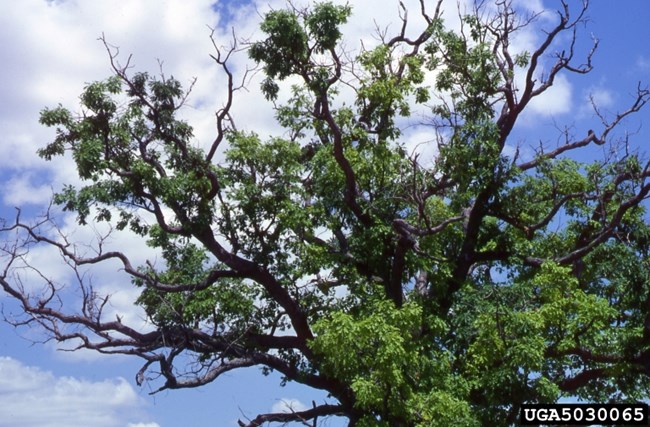Last updated: February 21, 2020
Article
Oak Decline

Joseph OBrien, USDA Forest Service, Bugwood.org
By Dorothy Borowy, Ecologist and Integrated Pest Management Coordinator for the National Capital Area
What is oak decline?
For centuries, oak trees (genus Quercus) have dominated forests of the Eastern United States. They are vital components of deciduous forest ecosystems and are one of North America's most valuable hardwoods. In recent years however, populations of many oak species have dramatically declined. Symptoms include early browning of leaves, thinning of canopy cover, and loss of branches, which can eventually lead to tree mortality. Understanding and preventing this phenomenon has been challenging, given that no single factor is responsible for what is generally defined as Oak Decline.
A host of stressors including climate, tree age, site conditions, and history of disease interact to weaken trees over time, ultimately leading to sudden* death when the tree’s resources are exhausted. This "death by a thousand cuts" makes prevention of oak decline difficult, as stressors can vary both over time and by location.
Invasive pests, drought, fire suppression, and soil compaction from human activities are among the primary factors influencing oak decline in our region in recent years. Although most healthy, mature oaks can contend with one or a few of these stressors, in combination, they weaken the tree and make it more susceptible to secondary factors, such as fungal and bacterial infections. In the National Capital Area, Armillaria root rot fungus, two-lined chestnut borer beetle (Agrilus bilineatus), and bacterial leaf scorch (caused by Xylella fastidiosa) are commonly blamed for killing oaks, even though they typically only attack trees that are already in a state of decline.
What can you do?
Despite these factors, there are ways to prevent oak decline; by maintaining oak trees in a healthy state you can limit the impact of different stressors. This may include,
- Removing invasive vines from trees
- Avoiding damage to tree limbs, trunk, and roots
- Monitoring trees for insect pests and fungal and bacterial infections
- Pruning damaged/diseased limbs
- Mulching around the base of trees to protect roots
- Watering trees during dry spells and limiting pesticide use
- Consulting with local forestry experts and ISA Certified Arborists for advice and assistance on tree-related issues
*Oak decline differs from Sudden Oak Death (SOD), which is caused by Phytophthora ramorum, a tree pathogen that is not present in the Mid-Atlantic region.
References
Appleton, Bonnie. Virginia Cooperative Extension. Twenty-four Ways to Kill a Tree.
Arlington, VA. 2019. Oak Decline
Chamberlin, Lori. Virginia Department of Forestry Oak Decline in Virginia
University of Maryland Extension. Browning of White Oaks in 2019
Tags
- anacostia park
- antietam national battlefield
- baltimore-washington parkway
- catoctin mountain park
- chesapeake & ohio canal national historical park
- fort dupont park
- fort foote park
- fort washington park
- glen echo park
- great falls park
- greenbelt park
- harpers ferry national historical park
- kenilworth park & aquatic gardens
- manassas national battlefield park
- monocacy national battlefield
- national capital parks-east
- national mall and memorial parks
- piscataway park
- prince william forest park
- rock creek park
- wolf trap national park for the performing arts
- ncrn
- integrated pest management
- tree diseases
- oak decline
- quercus
- forest health
- ncr
- natural resource quarterly
- spring 2020
